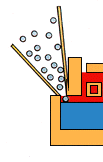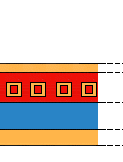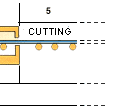Floating
From DDL Wiki
| Line 1: | Line 1: | ||
Page under construction by: | Page under construction by: | ||
| - | [[Image:verreplat_schema.gif|frame| | + | [[Image:verreplat_schema.gif|frame|right|Floating Glass Manufacturing Process]] |
=Process= | =Process= | ||
Revision as of 13:08, 7 September 2007
Page under construction by:
Contents |
Process
Float glass is produced first by forming molten glass from raw materials, such as silica sand, calcium, iron oxide, soda, and magnesium. These raw materials are heated to approximately 1500 °C within a furnace to form the molten glass. The molten glass then flows from the furnace onto a pool of molten tin, called a tin bath. The glass does not mix with the molten tin. Under the influence of gravity, the glass slowly flattens until both surfaces are perfectly flat. Finally, the molten glass is cooled to room temperature, resulting in the final product of a perfectly flat sheet of glass.
Advantages Over Other Methods
Floating creates a superior quality of glass compared to other methods of creating flat sheets of glass. The nature of the production method ensures that the two sides are parallel as well as smooth. Other production methods often relied on manually polishing the sides of the glass. While this could potentially create glass of similar quality to floating, it was a much more expensive process.
Limitations
The floating process can only create flat sheets of glass. However, other processes such as shearing can be used to cut this flat sheet into various shapes as necessary.
References
http://www.saint-gobain.com/en/html/groupe/verre_plat.asp
http://en.wikipedia.org/wiki/Float_glass
Created by Robert Gimson, Richard Hauffe, Chris Cavanaugh, Jon Bodnar






